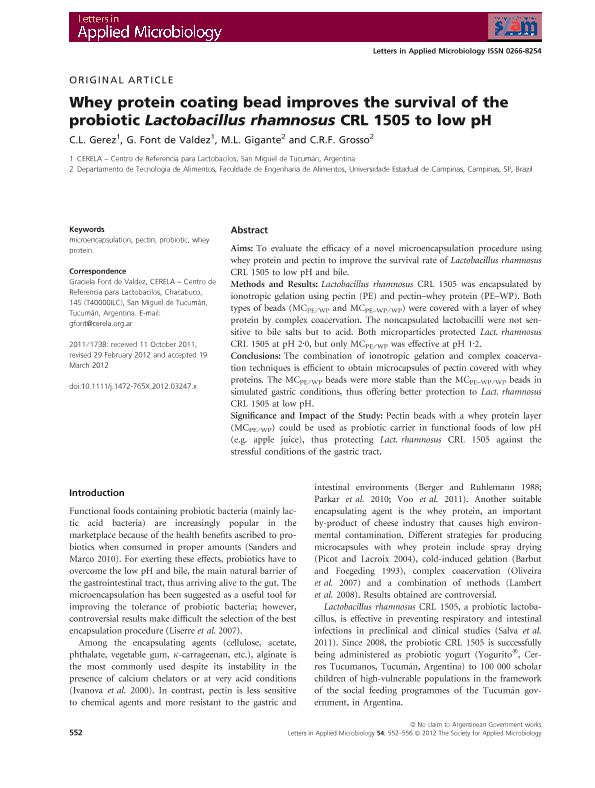Artículo
Whey protein coating bead improves the survival of the probiotic Lactobacillus rhamnosus CRL 1505 to low pH
Fecha de publicación:
04/2012
Editorial:
Wiley
Revista:
Letters In Applied Microbiology
ISSN:
0266-8254
e-ISSN:
1472-765X
Idioma:
Inglés
Tipo de recurso:
Artículo publicado
Clasificación temática:
Resumen
Aims: To evaluate the efficacy of a novel microencapsulation procedure using whey protein and pectin to improve the survival rate of Lactobacillus rhamnosus CRL 1505 to low pH and bile.
Methods and Results: Lactobacillus rhamnosus CRL 1505 was encapsulated by ionotropic gelation using pectin (PE) and pectin–whey protein (PE–WP). Both types of beads (MCPE/WP and MCPE–WP/WP) were covered with a layer of whey protein by complex coacervation. The noncapsulated lactobacilli were not sensitive to bile salts but to acid. Both microparticles protected Lact. rhamnosus CRL 1505 at pH 2·0, but only MCPE/WP was effective at pH 1·2.
Conclusions: The combination of ionotropic gelation and complex coacervation techniques is efficient to obtain microcapsules of pectin covered with whey proteins. The MCPE/WP beads were more stable than the MCPE–WP/WP beads in simulated gastric conditions, thus offering better protection to Lact. rhamnosus CRL 1505 at low pH.
Significance and Impact of the Study: Pectin beads with a whey protein layer (MCPE/WP) could be used as probiotic carrier in functional foods of low pH (e.g. apple juice), thus protecting Lact. rhamnosus CRL 1505 against the stressful conditions of the gastric tract.
Palabras clave:
Lactobacillus Rhamnosus
,
Whey Protein
,
Microencapsulation
,
Pectin
,
Probiotic
Archivos asociados
Licencia
Identificadores
Colecciones
Articulos(CERELA)
Articulos de CENTRO DE REFERENCIA PARA LACTOBACILOS (I)
Articulos de CENTRO DE REFERENCIA PARA LACTOBACILOS (I)
Citación
Gerez, Carla Luciana; Font, Graciela Maria; Gigante, Mirna L.; Grosso, Carlos; Whey protein coating bead improves the survival of the probiotic Lactobacillus rhamnosus CRL 1505 to low pH; Wiley; Letters In Applied Microbiology; 54; 6; 4-2012; 552-556
Compartir
Altmétricas




